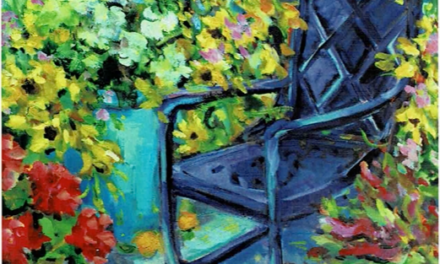 “How to stay current without latching onto every trend, how to age without growing into a cranky old [fool] mired in the past—those were my questions. I drew inspiration from my grandparents’ generation, because it more than my parents’, lived through a time of dizzying technological change, radical upheavals in society.
“How to stay current without latching onto every trend, how to age without growing into a cranky old [fool] mired in the past—those were my questions. I drew inspiration from my grandparents’ generation, because it more than my parents’, lived through a time of dizzying technological change, radical upheavals in society.
My paternal grandmother, Rose, born in Chicago in 1894, married in 1913 wearing whalebone corset, was twenty-six before women won the right to vote. She lived well into the era of miniskirts and the feminist movement. She remembered horse-drawn fire engines, gaslight, wooden sidewalks, and hearing about the Wright Brothers’ first flight. At seventy-five, in my parents’ family room, she sat beside me watching Neil Armstrong set foot on the moon, shaking her head in disbelief.” – Philip Caputo, The Longest Road (Henry Holt and Company, 2013)
My dear mother, Marguerite, passed away peacefully last month at 86 in her beloved home in Connecticut. Born in 1930, she grew up hearing her father grumble, ‘then Margie was born and the Depression hit.’ Whatever optimism she mustered in life was hard fought. Fortunately for us all, she married a particularly fine and optimistic man, my dad. She loved him above all else, from her pretty teenage glances soon after the war until he died over fifty years later.
Her loss leaves me even more uneasy, wrestling with time and mortality, than I would have guessed. This musing was reinforced last week when our older son Jack implored us to please stay around long enough to at least see him get married. We’ve all had a jolt lately of the reality of time’s inexorable march. Maybe that’s why I’ve been absorbed in the “That’s Entertainment” series on Turner Classics. Those gleaming stars of the thirties and forties—Fred Astaire, Judy Garland, Gene Kelly, June Allyson, Debby Reynolds and so many others—those were my mother’s stars, and those of her generation. When Jane and I watched the dazzling Clark Gable in 1935’s “Mutiny on the Bounty” the other day, I was again awash in feelings of both nostalgia and sorrow, warmth and anxiety, connection and impending—well, eventually—detachment from all that surrounds me. The world as we know it.
Suddenly there seem to be clocks everywhere, this from a guy who seldom wears a watch and can’t be bothered to read the time on my cell phone since it requires reading glasses. I started thinking about cats and their reputed nine lives. The feral cats on Saint Helena Island pulled harder than ever at my heart. Where and how do they hunt down their next meal? Who takes any responsibility for them? Do folks care much? Are these feral creatures just part of the background noise of everyday life, nearly silent wisps of life who enliven the shadows for a few years and then die—perhaps miserably—in a dark corner somewhere out of sight?
Jiminy Cricket, one of Disney’s all-time film greats, was ‘born’ cinematically in “Pinocchio” in 1940. He popped into my head and suggested that maybe I should reach out to some of those cats. I bought a bag of cat food and dumped it in the bushes where I’d been noticing these critters. Checking back the next day, I found… nothing. Not a crumb of food. At first, I wondered if someone had come by and cleaned (vacuumed?) it all up. There was a public building nearby, after all. So I tried it again, this time with two bags. Again, they rapidly disappeared. Poof! By the fifth or sixth drop off, I thought I might have been busted. An elderly man (hey, even older than me) saw me dumping a bag and said, ‘Hey, you feedin’ the critters?’ I admitted yes, I was, and something to the effect that we are all God’s creatures. ‘Good fer you,’ he replied, ‘they kin shur use some hep jes like evah buddy else.’ We exchanged smiles on a sparkling day and got back in our cars. Mine took a good hour to wear off (no, not the car).
Time, whatever it is, seems to be bending all around me. Taking a welcome break from chores and paperwork, I hung out at the Film Festival for a few hours. Every second there I tried to stretch into a minute or two. Some of the films seemed tailor made for these moments. “We Can’t Die”, written and directed by LuAnn Nicosia, featured a struggling screenwriter who regained his equilibrium and motivation to continue his work when he dreamed about some of his characters, plucked from times past, who conspired to convince him that they lived through him and weren’t ready to die yet. I thought of my adopted cats, our sons, my mom, and finally . . . my rumbling stomach. A timely everything bagel from the snack bar reset my inner clock and along with some back stretching, pushed me back to my cozy seat in the theater.
Show business still on my mind on the way home, I recalled Fleetwood Mac’s Stevie Nicks’ recent comments on staying young. She’s 68, often looks twenty years younger, but best of all seems to have the spirit of a millennial pulsing within her. She says she has no plans to retire, ever: “A friend told me that when you retire, you get smaller. Small means old, so I fight it with a sword. I’ll be on stage, dancing around, thinking, ‘Now let’s see… how old am I again? 110?’”
Back to the movies. For anyone lucky enough to see Eddie Redmayne play physicist extraordinaire Stephen Hawking in “The Theory of Everything,” for which he won multiple best actor awards, time may remain forever bent. Dr. Hawking was diagnosed with ALS in his twenties and given only a few years to live. Defying all odds, he remains quite alive and intellectually vibrant to this day. His most famous work, A Brief History of Time (Bantam, 1988), addresses the essence and intricacies of time itself. Got an itch to explore the concepts of black holes, the Big Bang, and general relativity? This is your book. Meanwhile, Hawking is seventy-five.
A wag once noted that if you give a five year old a hammer, everything he encounters looks like a nail. So it is with me and my newfound appreciation of time and how to bend it, work it to an advantage. Forty years ago my doctoral work focused on what cardiologists Myer Friedman and Ray Rosenman termed Type A behavior. They determined that so-called Type A’s were chronically tense, impatient and aggressive. And as a result, at higher risk of coronary events. Type A’s suffered from “hurry sickness,” the authors claimed.
Hurry sickness in various guises has been killing people for a long time. David W. Shaw’s brilliant The Sea Shall Embrace Them (Free Press, 2002) chronicles the perils faced by (frequently upscale) steamship passengers in the 1850’s who focused more on sailing from Liverpool to New York in under ten days, a breathtaking pace in those days, than on their basic safety en route. Nary a woman or child on the ill-fated Collins line ship Arctic lived through a fog-bound crash in September 1854. Women and children first? Not on that voyage as the selfish crew took precious time before sinking into their own greedy hands when they commandeered the ship’s grossly insufficient lifeboats.
It’s not just me, apparently. We all live much of our lives trying to cheat time, buy time. Remember that long-lived TV show Beat the Clock? A major news magazine this week devoted a fascinating series of articles to humans’ never ending quest to buy themselves longer leases on life. The magazine? Time, of course.
Time’s authors note three things we can all do to extend our lives, bend it to our advantage: stay curious (check), eat way more plants than you think you need to (I’m still working on that one), and rethink what it means to be old (hmm).
In the meantime, I’d give anything to have my mom back in her artistic prime. Maybe she’d enjoy seeing young, beyond handsome Clark Gable star in “Mutiny on the Bounty” just one more time. Mom, the tickets—and the popcorn– will be on me.








